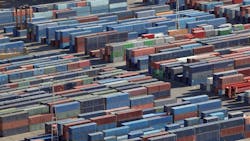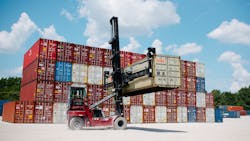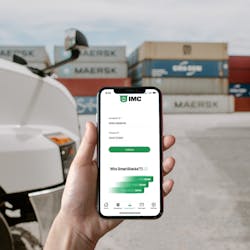How to build strategic relationships for intermodal success
Consider this. The Intermodal Association of North America (IANA) reported the following statistics regarding the continent’s intermodal industry:
- Includes more than 8,000 trucking companies and over 48,000 drivers.
- Uses 715,000 chassis and 2 million containers.
- Makes 98 million drayage and 19 million truckload hauls of more than 500 miles annually.
- Transports 60,000 containers and trailers daily.
- Moves 17 million loads by rail across every year.
So, what does it take to transport that volume of freight? Is it just equipment and drivers? Is it also advanced management processes and systems?
In both cases, “yes” is the correct answer, but there is one more essential factor to consider: The fundamental driving forces behind the successful transportation of intermodal freight across North America are the relationships between trucking companies, ocean carriers, railroads, brokers and 3PLs, and shippers.
- Holds long-term, strategic relationships with rail providers: When transportation and rail providers collaborate to provide for a consistent, regular volume of freight throughput, their strategic relationship results in more productive and efficient intermodal freight moves. For this relationship to form, the rail needs to know it can rely on a carrier to regularly provide a specific amount of volume. The carrier is then given that capacity before other providers.
- Continuously invests in shipping equipment for guaranteed capacity and visibility: The right equipment is essential for maximizing intermodal capacity. An intermodal carrier that owns and maintains its own chassis can avoid uncertainty in equipment availability, consistency, and reliability. A provider that invests in containers is also one with assured freight capacity.
- Manages dray transportation with its own team of professional, safe drivers: Companies that employ drivers rather than moving freight strictly through third-party capacity are less vulnerable to the impact of the driver shortage and are better able to meet shippers’ needs.
- Has a dedicated load engineer for optimization and safety: Transportation provider load engineers oversee outbound freight, analyzing loads and determining the most efficient way for them to move. They have advanced knowledge of how to optimize a container to maximize payload.
- Overcomes PSR-related freight disruptions: As rail networks shift to a new transportation model called Precision Scheduled Railroading (PSR), shippers can experience ramp closures and increased costs. To avoid inefficiencies, they can ship with intermodal transportation companies that use rail networks that have already implemented PSR and now offer decreased terminal dwell time, or with a multimodal service provider that can mix transportation modes.
- Facilitates a thorough onboarding process to mitigate freight mismanagement: A step-by-step onboarding process with specially trained intermodal team members ensures long-term success.
Schneider (No. 7 on the FleetOwner 500 For-hire) now services all of North America with more than 45 ramp locations, a vital part of the carrier’s plans to double its intermodal operation by 2030. “The combination of coast-to-coast connections and being an asset-based carrier with company drivers, company-owned containers, and company-owned chassis to operate on the railroad will result in more consistent service and less time in transit,” said Jim Filter, EVP and group president of transportation and logistics.
Building strategic relationships
J.B. Hunt also points to its longstanding relationships with intermodal rail providers as a means of ensuring reliable service. The provider of highway-to-rail-to-highway intermodal and BNSF Railway Co. recently launched a joint effort to improve capacity. As part of the initiative, BNSF will provide property locations around key intermodal hubs in Southern California, Chicago, and other markets.
See also: J.B. Hunt executives grow more cautious on market turn
J.B. Hunt’s plans include expanding its intermodal fleet by 40% in the next three to five years. The increased capacity, the company stated, means more customers can take advantage of cost-effective intermodal service options.
Other major intermodal service providers, such as Werner Enterprises (No. 14 on the FleetOwner 500 For-hire), leverage their partnerships with major railroads and drayage partners across North America as well. The company has regionally located customer service and planning resources in place to give customers access to market experts that help build strategic relationships. Additionally, it deploys a range of state-of-the-art technology created specifically for its intermodal business.
Stevens Transport (No. 52 on the FleetOwner 500 For-hire) also has developed strategic relationships with railroads and drayage facilities in key hub markets across North America. The company noted that a diversified network allows it to ensure timely and efficient movement of trailers while equipping all its trailers for highway and rail service helps guarantee maximum transportation flexibility.
How technology plays a role
Technology in drayage operations is important for decreasing container dwell time and improving driver and carrier productivity. In August 2022, IMC Companies, which operates seven regional marine drayage companies in the U.S. (currently being transitioned to do business under the IMC name), rolled out a proprietary version of the “peel pile” process called SmartStacks.
In a peel pile process, instead of waiting for a specific container located anywhere in the pile, drivers pull up to the indicated "pile" and take the top container to "peel" from the pile. With SmartStacks, multiple shippers' containers are placed into the same peel pile, and using IMC’s proprietary app, drivers can decide whether to deliver the container to its final destination or bring it to a nearby IMC depot.
See also: IMC's SmartStack app to speed up drayage
The SmartStacks approach addresses a challenge that has plagued shippers, ports, rails, the trucking industry, and consumers for years, IMC noted. It loosens the bottleneck on the supply chain that has inhibited container movement and driver productivity.
Another challenge to be addressed is connectivity between intermodal stakeholders. "If everyone was on a single platform, it would be easier to share information," said Barry Bernard, president of Ohio Intermodal Services, an IMC company. "It would lead to a higher level of understanding of the needs of all the players in different markets and regions."
Not to be overlooked is the role of technology in intermodal operations and business practices. "We have a proprietary internal system that connects drivers and dispatchers," Bernard related. "It facilitates the electronic transfer of information, dispatches, and documents.
"Behind the scenes we have tools that optimize operations," he added. "They calculate the next logical move based on location, appointments, a driver's available hours of service, and other factors. That not only boosts productivity but also helps keep our driver turnover low."
At Schneider, FreightPower is an online marketplace that allows you to instantly quote and book freight, have around-the-clock visibility, access to load documents, and real-time reporting. Shipper 360 by J.B. Hunt is designed to streamline quoting and booking and tendering new orders. It, too, provides visibility and access to real-time tracking, alerts for pickups, deliveries, appointment changes, and potential delays.
Freight visibility is a main design feature of the intermodal trucking platform offered by Axon Software. The company noted that with the TMS, customer satisfaction improves from having instant information available via web access and automated business triggers. The software also has built-in customization tools that can be used to adapt to a specific operation.
Tracking trends and costs
A SaaS-based platform that provides shipment execution and visibility across rail, truck, intermodal, barge, and ocean shipments is the IntelliTrans TMS solution.
"Modern technology enables a company to research, book and ship, track, and audit an intermodal shipment seamlessly from origin to destination, regardless of mode," said Ken Sherman, president of IntelliTrans. "Technologies like this also include procurement engines that enable shippers to book shipments in any mode and supply market data to help them confirm that their pricing is favorable based on market conditions."
"These technologies act as a fully integrated 'mission control' center for a shipper's logistics team," Sherman continued. "They leverage near real-time data to generate and update ETAs as new data arrives. They also automatically identify at-risk shipments and recommend or engage in actions that minimize delays, regardless of whether the issue is on the rail, ocean, or with a trucking company."
See also: CPKC adds 1,000 reefers to intermodal network
There are several reasons to use technology that can track trends in intermodal operations. By its very nature, for example, intermodal transportation involves multiple modes, which means costs can fluctuate, and there are other factors such as fuel prices, labor expenses, and equipment availability.
"Tracking transportation costs across modes helps identify cost-efficient transportation options," Sherman stated. "Understanding capacity constraints and demand patterns helps optimize transportation decisions and avoid capacity shortages or overcapacity situations."
Sherman recommends combining factors into comprehensive performance scorecards for each mode and supplier. That enables intermodal shippers to clearly identify where one party or mode excels over other options. It also helps provide a vehicle for performance improvement, constructive dialogue with various providers, and data-driven decisions.
"In 2023, we expect dray and rail operations to improve due to volume reductions and increased focus on service," Sherman said. "By collaborating to reduce requested lead time orders, shippers should be able to take greater advantage of intermodal opportunities."
"In addition, tracking shipments from origin to their ultimate destination allows shippers to be aware of performance changes," he added. "By partnering with a provider that has insight into a broader network, they can identify alternative ramps and routes to pursue."
A push for intermodal growth
To streamline intermodal freight handling, carriers, shippers, and third-party logistics providers must address some challenges.
"Carriers, shippers, and 3PLs all use different equipment, procedures, and technologies, which means there can be issues around communication, integration, standardization, and collaboration," Sherman pointed out. "These lead to inefficiencies and errors when handling freight and ultimately higher costs for all involved. Connecting carriers, shippers, and 3PLs in a centralized command center that covers all modes of transportation and integrates data makes it easier to communicate and do business.
According to a report on Research and Markets.com, the global intermodal freight transportation market is expected to grow by more than $50 million from 2022-2026. With that annual growth rate of about 6.4% during the forecast period, Sherman sees long-term strength in the intermodal market.
"But current conditions do not reflect an increase in volume in 2023 as intermodal volumes year-to-date are nearly 10 percent below 2022," he said. "With freight movement in many sectors down across all modes, we do not anticipate 2023 being a strong year for intermodal, but the second half of the year should be better than the first."
Barry Bernard noted that he anticipates a "push for intermodal freight" toward the end of the second quarter and into the third quarter of this year. "We don't have a crystal ball," he said, "but the versatility of intermodal operations will lead to higher volumes."
Intermodal transportation continues to be a viable option for shippers. Besides being cost-effective, efficient, and productive, it provides a high level of security and consistency. The real driving force behind intermodal freight across North America, however, remains the relationships between parties that keep freight moving.
About the Author

Seth Skydel
Seth Skydel, a veteran industry editor, has more than four decades of experience in fleet management, trucking, and transportation and logistics publications. Today, in editorial and marketing roles, he writes about fleet, service, and transportation management, vehicle and information technology, and industry trends and issues.





